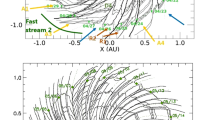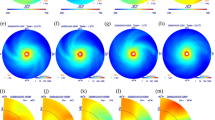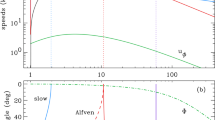Abstract
The potential-field approximation has been providing a fast and computationally inexpensive estimation for the solar corona’s global magnetic-field geometry for several decades. In contrast, more physics-based global magnetohydrodynamic (MHD) models have been used for a similar purpose, while being much more computationally expensive. Here, we investigate the difference in the field geometry between a global MHD model and the potential-field source-surface model (PFSSM) by tracing individual magnetic field lines in the MHD model from the Alfvén surface (AS), through the source surface (SS), all the way to the field-line footpoint, and then back to the source surface in the PFSSM. We also compare the flux-tube expansion at two points at the SS and the AS along the same radial line. We study the effect of solar cycle variations, the order of the potential-field harmonic expansion, and different magnetogram sources. We find that the flux-tube expansion factor is consistently smaller at the AS than at the SS for solar minimum and the fast solar wind, but it is consistently larger for solar maximum and the slow solar wind. We use the Wang–Sheeley–Arge model to calculate the associated wind speed for each field line and propagate these solar-wind speeds to 1 AU. We find a deviation of more than five hours in the arrival time between the two models for 20 % of the field lines in the solar minimum case and for 40 % of the field lines in the solar maximum case.









Similar content being viewed by others
References
Altschuler, M.D., Newkirk, G.: 1969, Magnetic fields and the structure of the solar corona. I: Methods of calculating coronal fields. Solar Phys. 9, 131. DOI . ADS .
Altschuler, M.D., Levine, R.H., Stix, M., Harvey, J.: 1977, High resolution mapping of the magnetic field of the solar corona. Solar Phys. 51, 345. ADS .
Arge, C.N., Pizzo, V.J.: 2000, Improvement in the prediction of solar wind conditions using near-real time solar magnetic field updates. J. Geophys. Res. 105, 10,465. DOI . ADS .
Cohen, O., Sokolov, I.V., Roussev, I.I., Arge, C.N., Manchester, W.B., Gombosi, T.I., Frazin, R.A., Park, H., Butala, M.D., Kamalabadi, F., Velli, M.: 2007, A semiempirical magnetohydrodynamical model of the solar wind. Astrophys. J. Lett. 654, L163. DOI . ADS .
DeForest, C.E., Howard, T.A., McComas, D.J.: 2014, Inbound waves in the solar corona: a direct indicator of Alfvén surface location. Astrophys. J. 787, 124. DOI . ADS .
Gilbert, J.A., Zurbuchen, T.H., Fisk, L.A.: 2007, A new technique for mapping open magnetic flux from the solar surface into the heliosphere. Astrophys. J. 663, 583. DOI . ADS .
Hoeksema, J.T.: 1984, Structure and evolution of the large scale solar and heliospheric magnetic fields. Ph.D. thesis, Stanford Univ., CA. ADS .
Lee, C.O., Luhmann, J.G., Odstrcil, D., MacNeice, P.J., de Pater, I., Riley, P., Arge, C.N.: 2009, The solar wind at 1 AU during the declining phase of solar cycle 23: comparison of 3D numerical model results with observations. Solar Phys. 254, 155. DOI . ADS .
Lee, C.O., Luhmann, J.G., Hoeksema, J.T., Sun, X., Arge, C.N., de Pater, I.: 2011, Coronal field opens at lower height during the solar cycles 22 and 23 minimum periods: IMF comparison suggests the source surface should be lowered. Solar Phys. 269, 367. DOI . ADS .
Levine, R.H., Schulz, M., Frazier, E.N.: 1982, Simulation of the magnetic structure of the inner heliosphere by means of a non-spherical source surface. Solar Phys. 77, 363. DOI . ADS .
Linker, J.A., Mikić, Z., Biesecker, D.A., Forsyth, R.J., Gibson, S.E., Lazarus, A.J., Lecinski, A., Riley, P., Szabo, A., Thompson, B.J.: 1999, Magnetohydrodynamic modeling of the solar corona during Whole Sun Month. J. Geophys. Res. 104, 9809. DOI . ADS .
Lionello, R., Linker, J.A., Mikić, Z.: 2009, Multispectral emission of the sun during the first Whole Sun Month: magnetohydrodynamic simulations. Astrophys. J. 690, 902. DOI . ADS .
Lionello, R., Mikic, Z., Schnack, D.D.: 1998, Magnetohydrodynamics of solar coronal plasmas in cylindrical geometry. J. Comput. Phys. 140, 172. DOI . ADS .
Luhmann, J.G., Li, Y., Arge, C.N., Gazis, P.R., Ulrich, R.: 2002, Solar cycle changes in coronal holes and space weather cycles. J. Geophys. Res. 107, 1154. DOI . ADS .
McComas, D.J., Velli, M., Lewis, W.S., Acton, L.W., Balat-Pichelin, M., Bothmer, V., Dirling, R.B., Feldman, W.C., Gloeckler, G., Habbal, S.R., Hassler, D.M., Mann, I., Matthaeus, W.H., McNutt, R.L., Mewaldt, R.A., Murphy, N., Ofman, L., Sittler, E.C., Smith, C.W., Zurbuchen, T.H.: 2007, Understanding coronal heating and solar wind acceleration: case for in situ near-Sun measurements. Rev. Geophys. 45, 1004. DOI . ADS .
McGregor, S.L., Hughes, W.J., Arge, C.N., Owens, M.J., Odstrcil, D.: 2011, The distribution of solar-wind speeds during solar minimum: Calibration for numerical solar wind modeling constraints on the source of the slow solar wind. J. Geophys. Res. 116, 3101. DOI . ADS .
Mikic, Z., Linker, J.A.: 1994, Disruption of coronal magnetic field arcades. Astrophys. J. 430, 898. DOI . ADS .
Mikić, Z., Linker, J.A., Schnack, D.D., Lionello, R., Tarditi, A.: 1999, Magnetohydrodynamic modeling of the global solar corona. Phys. Plasmas 6, 2217. DOI . ADS .
Odstrcil, D.: 2003, Modeling 3-D solar wind structure. Adv. Space Res. 32, 497. DOI . ADS .
Oran, R., van der Holst, B., Landi, E., Jin, M., Sokolov, I.V., Gombosi, T.I.: 2013, A global wave-driven magnetohydrodynamic solar model with a unified treatment of open and closed magnetic field topologies. Astrophys. J. 778, 176. DOI . ADS .
Pneuman, G.W., Kopp, R.A.: 1971, Gas-magnetic field interactions in the solar corona. Solar Phys. 18, 258. DOI . ADS .
Poduval, B., Zhao, X.P.: 2014, Validating solar wind prediction using the current sheet source surface model. Astrophys. J. Lett. 782, L22. DOI . ADS .
Powell, K.G., Roe, P.L., Linde, T.J., Gombosi, T.I., de Zeeuw, D.L.: 1999, A solution-adaptive upwind scheme for ideal magnetohydrodynamics. J. Comput. Phys. 154, 284. DOI . ADS .
Riley, P., Linker, J.A., Mikić, Z., Lionello, R., Ledvina, S.A., Luhmann, J.G.: 2006, A comparison between global solar magnetohydrodynamic and potential field source surface model results. Astrophys. J. 653, 1510. DOI . ADS .
Riley, P., Lionello, R., Linker, J.A., Mikic, Z., Luhmann, J., Wijaya, J.: 2011, Global MHD modeling of the solar corona and inner heliosphere for the whole heliosphere interval. Solar Phys. 274, 361. DOI . ADS .
Rušin, V., Druckmüller, M., Aniol, P., Minarovjech, M., Saniga, M., Mikić, Z., Linker, J.A., Lionello, R., Riley, P., Titov, V.S.: 2010, Comparing eclipse observations of the 2008 August 1 solar corona with an MHD model prediction. Astron. Astrophys. 513, A45. DOI . ADS .
Schulz, M.: 1997, Non-spherical source-surface model of the heliosphere: a scalar formulation. Ann. Geophys. 15, 1379. DOI . ADS .
Schulz, M., Frazier, E.N., Boucher, D.J. Jr.: 1978, Coronal magnetic-field model with non-spherical source surface. Solar Phys. 60, 83. DOI . ADS .
Sokolov, I.V., van der Holst, B., Oran, R., Downs, C., Roussev, I.I., Jin, M., Manchester, W.B. IV, Evans, R.M., Gombosi, T.I.: 2013, Magnetohydrodynamic waves and coronal heating: unifying empirical and MHD turbulence models. Astrophys. J. 764, 23. DOI . ADS .
Toth, G., Sokolov, I.V., Gombosi, T.I., Chesney, D.R., Clauer, C.R., De Zeeuw, D.L., Hansen, K.C., Kane, K.J., Manchester, W.B., Oehmke, R.C., Powell, K.G., Ridley, A.J., Roussev, I.I., Stout, Q.F., Volberg, O., Wolf, R.A., Sazykin, S., Chan, A., Yu, B., Kóta, J.: 2005, Space weather modeling framework: a new tool for the space science community. J. Geophys. Res. 110, 12,226. DOI . ADS .
Tóth, G., van der Holst, B., Sokolov, I.V., De Zeeuw, D.L., Gombosi, T.I., Fang, F., Manchester, W.B., Meng, X., Najib, D., Powell, K.G., Stout, Q.F., Glocer, A., Ma, Y.-J., Opher, M.: 2012, Adaptive numerical algorithms in space weather modeling. J. Comput. Phys. 231, 870. DOI . ADS .
van der Holst, B., Sokolov, I.V., Meng, X., Jin, M., Manchester, W.B. IV, Tóth, G., Gombosi, T.I.: 2014, Alfvén Wave Solar Model (AWSoM): coronal heating. Astrophys. J. 782, 81. DOI . ADS .
Wang, Y.-M., Sheeley, N.R.: 1990, Solar-wind speed and coronal flux-tube expansion. Astrophys. J. 355, 726. ADS .
Wiegelmann, T., Sakurai, T.: 2012, Solar force-free magnetic fields. Living Rev. Solar Phys. 9, 5. DOI . ADS .
Acknowledgements
Simulation results were obtained using the Space Weather Modeling Framework, developed by the Center for Space Environment Modeling, at the University of Michigan with funding support from NASA ESS, NASA ESTO-CT, NSF KDI, and DoD MURI.
Author information
Authors and Affiliations
Corresponding author
Ethics declarations
Disclosure of Potential Conflicts of Interests
The author, Ofer Cohen, declares that he has no conflicts of interest.
Rights and permissions
About this article
Cite this article
Cohen, O. Quantifying the Difference Between the Flux-Tube Expansion Factor at the Source Surface and at the Alfvén Surface Using a Global MHD Model for the Solar Wind. Sol Phys 290, 2245–2263 (2015). https://doi.org/10.1007/s11207-015-0739-3
Received:
Accepted:
Published:
Issue Date:
DOI: https://doi.org/10.1007/s11207-015-0739-3




